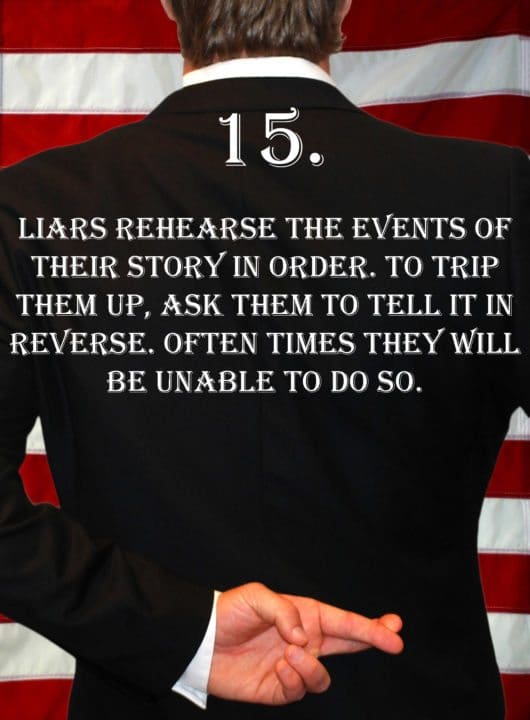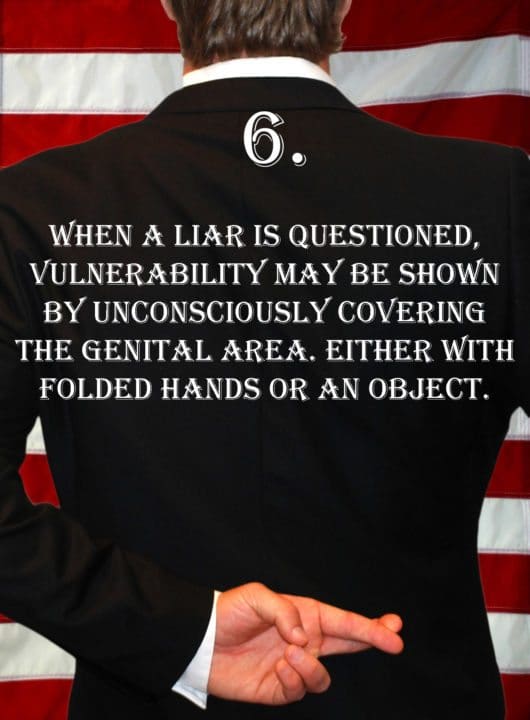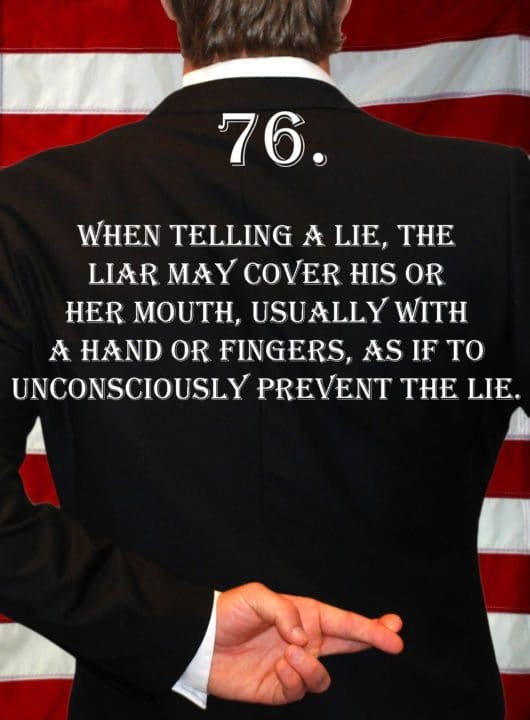
Deception Tip 15:
Liars rehearse the events of their story in order. To trip them up, ask them to tell it in reverse. Often times they will be unable to do so.
Listen To The Podcast!
E15 – Rehearsed Stories – Deception Tips Podcast – Click Here To Subscribe
Podcast Transcript
Hello, and welcome to the Deception Tips Podcast, where you will learn amazing cues to detect deceit that will help you read people like never before. I’m your host, Spencer Coffman. Let’s get started.
Welcome back to another episode of the Deception Tips Podcast. This is episode 15. Last time, we talked about a sign of deception that is something you can easily notice and it is appearing on the face. We talked about symmetrical expressions. I told you that smiles are the most easily determined expression when it comes to symmetricality and, oftentimes, you can really determine whether or not someone is being truthful based on their smile.
Smiles often show up in lies and liars often smile when they tell lies because they want to convey that everything is normal, everything is alright. It’s happy, “I feel good about this. I’m not lying.” And that’s contradictory to a lot of beliefs where most people don’t think that “Oh if you are smiling you must be lying.” No, it’s wrong. If you smile, you may not be lying, or you may be lying.
Smiles can happen at any time. Maybe they are telling a funny story and their lie is a funny story and they smile because it’s funny. You never know. So, smiles are not always apparent in lies, but they can be apparent in lies. In addition, if a smile is apparent in a lie, it will be asymmetrical.
Now, these asymmetrical expressions often appear on the left side of the face more than the right. This is because the left side of the face is controlled by the right side of the brain and the right side of the brain is more involved in deceptive, or false emotions.
Now, when I say left brain and right brain you don’t have two different brains. I’m talking about the right cerebral hemisphere and the left cerebral hemisphere. So, the right cerebral hemisphere has more involvement in false emotions than the left cerebral hemisphere.
This is why false emotions are more asymmetrical, or are more displayed, on the left side of the face. You’ll often see that a smile that starts out or is only on the left side of the face, will typically be a fake smile. So, keep an eye out for asymmetrical behavioral expressions. This not only goes for facial expressions but also behavioral expressions as well.
We talked a few weeks ago about the importance of simultaneous gestures. This is kind of a symmetricality event as well. When people talk and they point or they talk and use their arms to emphasize things, those need to be symmetrical with what they’re saying and with the speech that they are putting out. We said they need to be congruent, but symmetrical is another great word to talk about that.
Today, we are going to talk about another form of deception, that is one to which you need to pay attention because it is not a form of leakage. It is more a form of rehearsal, or speech patterns, that you need to solicit when questioning someone or when bringing it out.
It is sort of along the lines of the deceptive tips that require you to stay silent or to accept someone’s lie in order to get them to believe you and then come out and tell a different lie or tell the truth.
So, these are more strategies and things that you can do to trip liars up. They’re not necessarily forms of leakage, behavioral slippage, or signs of deception. They’re things that you need to do or you need to pay attention to. Its weapons of attack that you can bring little things out of your toolkit, or your toolbox, or tool belt, or wherever you want to come from. These are things that you can do to trip up liars and get them to reveal the truth.
Today, the one we are talking about is a story. So, liars often rehearse their stories, but one thing that they often do is that they rehearse them in order. So, they rehearse a series of events.
I proposed a story a couple of times ago to you about riding your bike and they said, “Ok. We’re going to tell them we were riding our bikes. We stopped at a store. We left the store. Then we found these knives on the side of the road.” Then you could propose a different alternative. “Where did they find them?” “Oh, they were on the sidewalk.” That was from a couple of weeks ago, but it’s a story. They rehearsed that story in order. Liars often rehearse things in order.
So, here is Deception Tip 15, and it deals with stories being rehearsed in a way that you can combat that, and get people to trip up, and stumble over their lies by using a strategy of your own.
Here it is. Deception Tip 15: Liars rehearse the events of their story in order. To trip them up, ask them to tell it in reverse. Oftentimes, they will be unable to do so. Here it is again. Liars rehearse the events of their story in order. To trip them up, ask them to tell it in reverse. Oftentimes, they will be unable to do so.
Now, this is very important because liars rehearse a story in order. They never think to rehearse it in reverse or backward. That would be silly. It’s kind of unconventional. In addition, when you tell a story, you tell it in order. You never tell things backward.
However, this is a little tip that we’re going to talk about way down in the future, oftentimes when people tell their stories, they aren’t always in order step by step. It’s not a tutorial or a how-to video or a series of events. It is a series of mix-match puzzles back and forth.
Usually, when people tell stories they say stuff like, “Well, yesterday I went to the post office and when I was buying stamps I was in line and the person was so rude to me. And then when I got up to the counter, the person was selling me the stamps and, for crying out loud, they didn’t want to sell me a 1-cent stamp because they didn’t believe that they had a certain centage of stamps. They thought it was always a ‘forever’ stamp. They said, ‘We’ve had forever stamps for years now so why on earth would you need a 1-cent stamp?’”
Well, you notice in that story, I was saying how I was at the post office, and then I was in the line, and then the person was rude. They weren’t in a series of events. If I had told that in order, it would be, “I went to the post office. I got in line. Then I did this.
Then the person told me ‘x-y-z,’ and they were so rude, and this followed.” It would be a 1–2–3–4 series of events. Whereas instead, you’ll see my true story, it kind of jumped back and forth a little bit. I may have forgotten something. I added something.
When people tell narratives, it’s not always in narrative form. It’s a narrative form in that they’re telling a story, but the events do not always appear sequentially. So, when liars tell their stories, their stories appear sequentially. So, this is one sign of deception.
The other sign is when you get them to tell it backward, they can’t do so. However, if you tell me to tell that post office story backward, I can very easily. I can say, “Yeah! The person didn’t want to sell me the stamp. I was there talking to him. I got in line and then I got to the post office.”
So that would be a reverse of it and it’s a summary. Most liars do not rehearse their stories in reverse. We will talk more about this, right after this. Stay tuned.
Want to be a lie spotter but don’t have time to do the research? Check out Spencer Coffman’s Deception Tips blog and learn how to detect deception. You’ll be an expert at detecting lies. That’s spencercoffman.com
When liars rehearse their story it never occurs to them to rehearse it in reverse. Why would you rehearse something in reverse? You’re not going to. But, when you record a true memory, a real-life memory, you remember everything about it.
Now, you don’t remember everything as in all the details and every little thing. But, you remember a general consensus of the story. “Yesterday, I went to the supermarket and I bought some watermelon and some mangoes and then when I was checking out, I dropped the watermelon and it burst all over the floor. The people there were so nice! They came over and cleaned it up for me. The one guy even went back and got a watermelon for me to check out and then I could leave the store.”
If that was a lie and you asked me to tell it backward, I wouldn’t be able to do so. But, if it’s the truth I’ll easily remember it because it happened to me and, in that story, it was such an impactful story that you’re going to remember it.
So, you say, “Okay. Tell it to me in reverse.” I say, “Yeah. The guy got me a watermelon off the shelf. They cleaned up the mess. I dropped the watermelon. I bought the watermelon and some mangoes and I went to the supermarket.” That is the exact reverse.
Feel free to re-run it and play-by-play. I don’t have a script in front of me. I’m not reading anything. All of the stuff that I do with you guys, for this podcast, is freestyle. It’s all out of my head as it goes. That’s why you may hear some mess-ups, some slip-ups because I have no script. It’s all spewing out, free-flowing words that you guys are hearing from my mouth to you.
So, that story happened. I told it in reverse. No big deal. But, if I told a lie and then you told me to tell it in reverse, oftentimes, they’ll attempt to tell you the story in reverse but they will be unable to do so.
Take the watermelon example and they may say something like, “Well, I was at the supermarket. I dropped the watermelon. Uh, they cleaned it up. Oh, I got some mangoes and I checked out.” Ok. Well, that story wasn’t in order and it was kind of in reverse, but they started out with “I went to the supermarket.” Then they went to the end of the story, then the middle, then kind of back and forth. So, it really was a struggle for them to say that in reverse.
Whereas, when something happens in real life, oftentimes people will summarize it. So, if you say the watermelon story and you say “Tell it to me in reverse,” the person would say something like, “I got a new watermelon. I dropped the watermelon. I checked out of the store. I went to the store. Ok. Are you happy?”
Because usually, they get upset when you ask them these questions because it is kind of like a stupid question. But, it’s not a stupid question because it has a definite purpose, but to them, it is a stupid question.
Sort of like these pseudos, or fake, type psychological questions or evaluating questions. My favorite type of job interview was when I would ask people, “If you could be an animal, what animal would you be and why? What color would you be if you could be a color?”
I mean people just go nuts when you hear these things but you know what? It tells them a lot. By what type of animal, what type of color, you know what you’re looking for. You know who you’re dealing with. You know what type of person they are.
Or those common games people play where they say, “Okay. I’ll say something and then you say the first thing that comes to mind.” So, you can try it right now. Furniture. Clothing. Color. What came to your mind when those things happened?
Furniture- most people say a couch or a chair. Clothing- most people say pants or shirt. Color- most people say red or blue. It’s a very definite thing where there are specific solicited responses or common responses that most people think of, or that the general population thinks of.
And, if you can ask these questions, people get a general response, you know you that it’s a general, typical response. It’s the average. Ok. It’s kind of true.
So, when you tell people to tell their story in reverse, they interpret it as that kind of pseudo-science, fake questioning, or stupid questioning and they may get a little mad about it.
So, if they’re telling the truth, they’re going to give you a snippy response, but they’re going to be able to tell you in reverse. Then you know it’s the truth and you just move on. However, on the chance that you were right, and they were telling a lie, and they can’t tell the story in reverse, you have caught them red-handed.
In addition, you could pay attention to some other signs of deception and you’ll know for sure that they were telling a lie. This is one of the greatest tactics to use. Especially when people are telling their story in a series of events because they’ve rehearsed that lie.
They’ve maybe even practiced that lie. If they think about things ahead of time, liars often practice their lies. They’ll rehearse it. Some people go as far as rehearsing it in the mirror.
Other people will even maliciously think of things like, “Well, ok. Wait a minute. It sounds more truthful if I pause here and here. It also sounds more truthful if I pretend that I forgot a detail and then come back and add it later.”
Or, “It sounds more truthful if I say, ‘Well, yeah. I went to the store and then when I was at the post office, oh wait a minute. Before I went to the post office I got a flat tire and then I had to change the tire and while I was doing that some guy stopped to help and he dropped his wallet and then that’s when this happened and that was the last time I saw him. Then he died.’”
Or something and they’re being questioned for the murder of that guy because they were the last person to see him alive. And, they added those details that they forgot.
That could be a true story, but if someone was lying about it, and they maliciously, intentionally added some certain details and pretended to forget some certain details, then it does sound a little bit more truthful.
However, they may have thought far, but they didn’t think far enough. Because, if you say, “Ok. Tell it to me in reverse.” Now, they’ll be lost because they purposefully rehearsed it and added certain things that they forgot.
So, if you ask them to tell it in reverse, which reverse are they going to tell it in? Are they going to tell it in reverse in the series that it actually happened or are they going to tell it in reverse of what they just told you? Typically, they’ll tell it in reverse of what they told you.
So, even if they tell you something out of order if it’s true, and they forgot a detail and brought it back, the reverse that they give you- if it’s true- will be the reverse of how they told it to you because that is the thing that is most fresh in their memory.
Of course, if they tell you the reverse of the series of events that really happened, then they’re still probably telling the truth. It just depends on how long it’s taken them to think of it, how they do it, etcetera. And, of course, other signs of deception.
So, this is a great tool to use. It’s a great tactic for you to use. Pay attention to it. Use it when it’s necessary. In addition, pay attention to clusters and patterns of behavior as well. They’re very important.
Thank you for listening to this week’s episode of the Deception Tips Podcast. I encourage you to share it with your friends, subscribe to the feed, check out the Deception Tips blog, and take a look at the books I have available. And, as always, tune in next week for a new Deception Tip.
Video Transcript
Hey guys, my name is Spencer Coffman. Thank you for watching the Deception Tips videos, they’re all about teaching you how to read people and detect deception
so that you will be able to tell if someone is lying to you.
Today, we are going to talk about a little trick that you can use to kind of trip up a liar and to get them to reveal the truth and kind of to prove whether or not they are really lying. So this would typically be done after you have started to notice some
different signs and patterns.
Maybe you’ve seen a few clusters of behavior or some things that you may notice that “oh, they might be lying,” or “that might not be true,” or something where you’re a little bit uncertain and you need a further confirmation. And now, you could do this even if you’re certain they’re lying.
You could just do this as like, a double confirmation just to kind of reassure yourself that you were right, or something like that. Because it’s a really kind of a neat trick, and it’s cool to watch happen when you ask somebody that, it’s like a little experiment you can conduct and see the results happen right away, instantly. And it’s kind of like a little psychological experiment, or a test that you can do. So if that intrigues you, then this is one you’ll definitely want to use and keep it in mind.
So here it is, deception tip number 15: Liars rehearse the events of their story in order. To trip them up, ask them to tell it in reverse. Oftentimes, they will be unable to do so.
So, as you know, things are rehearsed in order. This really, this tip is for liars who have rehearsed a story or planned out their lie. It’s not really for something that would be a spontaneous lie, such as if you get your haircut yesterday and then you go to someone today and they didn’t know you got your haircut, and you say, “hey, do you like my haircut?” And they, and maybe it’s like a really terrible haircut, and they’re like, “oh, yeah, it’s great.”
That would be a spontaneous lie. You can’t really say, “hey, tell me that backward,” because that wasn’t a sequence of events. This needs to be something that they’re rehearsing, like “yesterday, I went to the grocery store, I bought eggs, I bought milk and peanut butter, and then I left.” Something like that. And you can say, “well wait a minute, did you pay for the groceries?” And they say, “oh, yeah, I paid for them.”
And then if you could say, they could tell it in reverse, and then they’d be unable to do so, “oh, maybe you stole those groceries.” Bad example, but you get the idea that it only will work when they have a sequence or a series of events. This has to be something that has played out in their head, it’s a narrative.
When they’re telling a narrative, a story, then you can say, “hey, tell it to me backward,” because people will be unable to do so. And now, to prove this out, you’ve probably experienced this at some point in your life. Everybody in the English language who grows up with it, or even when they learn the English language, they know the ABC’s. It’s a typical song.
We also know how to count, 1, 2, 3, 4, a, b, c, Etc., it’s a linear progression.
Humans are very, very linear, and we like narratives. We like things to be in order, and they just flow naturally. However, if you’ve ever had someone say, “hey, say the ABC’s backward,” most people just kind of say, “well, Z, Y, X, W,” and maybe that’s where they get confused, and they can’t go any further. Because we rehearsed it in order. We rehearsed and memorized ABC, we didn’t memorize ZYX, Etc. We memorized ABC, and it’s that order.
For example, also, we learned how to count, from when we were little, in order. 1, 2, 3 up to 10, and then continuing. However, we didn’t really learn how to count backward until we started consciously doing it. Count backward from a hundred, the first time you did that, you really had to think about it. Now that you’re older, it’s kind of a habit. You’ve memorized it, you’ve done it enough times that you could easily come back from
100. However, the ABC’s backward might still trip you up. This is because it hasn’t been rehearsed backward. You’ve only rehearsed it forwards.
So liars, when they’re telling a narrative, typically, they are so worried and so stressed and under so much pressure and tension, that they are only thinking about getting that story out. It didn’t occur to them that, “hey, well maybe I need to rehearse it forwards, backward, sideways, everything so I have every little detail.” And that is actually another tip – when Liars have too much detail, which we’ll come to that later on, that it could be another sign of deception.
So either way, they’re in trouble because no matter what they do. But if you can use this little tip, to tell them or ask them to tell their story backward, it may help you determine whether or not they are telling the truth. Now here’s a little pointer, liars will usually be unable to do so. So if you say, “tell it to me backward,” they may struggle. They’ll try, and they may get them out of order.
But, how much out of order and whether you think that’s a proof for a lie is up to you to discern between the other signs that happen. However, if you ask someone to do this and they are telling the truth, they will most likely get irritated with you. Then they will probably state it in order like summary, like, “Bought the eggs, bought the milk, bought peanut butter, went to the grocery store. Okay? Are you happy?” Something like that.
They’re going to be very irritated with it, they’re going to be kind of insulted that you asked them to do such a stupid thing, but it’s really not stupid. There’s a reason for it. It’s one of those pseudoscience things that they think it’s fake science, but really there is a reason behind it. And it helps you determine whether or not someone is telling the truth. So use it as a part of your toolkit to tell whether or not someone is being deceptive and to kind of further prove whether or not you suspect someone of being deceptive.
If this is your first time watching these videos, I would love to have you subscribe to the channel on YouTube. Feel free to leave comments on them with any questions as well. In addition, if you’d like more information, we’ve got books, podcasts, and blog posts, articles, all available on SpencerCoffman.com, that will teach you more about what every body is really saying.
Until next time.






